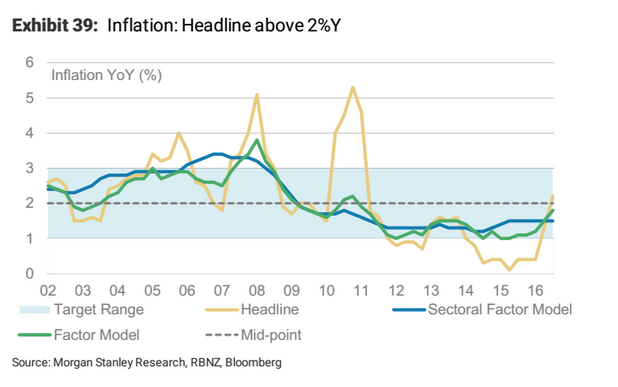The New Zealand Dollar is Set to Gain, According to Morgan Stanley

The New Zealand Dollar stands out as one of the currencies to watch, according to analysts at inevstment bank Morgan Stanley.
It's outlook is supported by a strong economy, rising inflation, a healthy labour market and rising demand for its unique exports.
Headline inflation has now moved above the mid-point of the Reserve Bank of New Zealand’s (RBNZ’s) target range, indicating it is close to being uncomfortably high.
It is unlikely the RBNZ will raise interest rates, however, as the rise in prices is mostly due to, “one-off effects in energy and prices” and the RBNZ’s threshold for changing its policy stance is quite high.
Like most of the rest of the world wage inflation in New Zealand has remained stubbornly low despite labour market tightening.
This is partly due to the effect of high net immigration of unskilled labour keeping wages low, but this is set to change now that the government has made criteria for entry into the country more demanding.
“If recently announced higher hurdles for immigration slow the expansion of low-skilled labour supply while unemployment continues lower, wage inflation should start coming through more meaningfully,” said Morgan Stanley’s Hans Redeker.
If inflation continues rising, the pressure will increase on the RBNZ to raise interest rates, and there is a strong possibility this might happen at the end of 2017 or early 2018, according to Morgan Stanley.

A rise in interest rates will help support the New Zealand Dollar (Kiwi) as higher interest attracts inflows of more capital.
Investors are likely to target the NZD for the purposes of carry trading in which they borrow money in a low interest rate jurisdiction in order to invest in a currency with a higher interest rate, such as NZD, enabling the investor to profit from the difference.
Unlike the Australian Dollar, NZD is not as dependent on China and heavy commodity exports like iron ore.
The main export for New Zealand is whole dried milk and recent Global Dairy auction have fixed higher prices for dairy products boosting demand for the Kiwi in the process.
An expected increase in public spending from the government is likely to be a supportive factor for the Kiwi as it will help fuel growth and inflation, further raising the chances of the RBNZ tightening monetary policy.
Technical Analysis of GBP/NZD
The positive fundamental outlook for the Kiwi is reflected in the recent price action of the GBP/NZD pair, which was rising after forming a double bottom, but then made a rapid reversal and fell steeply back down.
The pair has now met strong support from the neckline of the double bottom, which is the level of the intervening peak between the two troughs of the pattern.
This level is likely to act as an obstacle – or ‘support’ in technical parlance – preventing further downside.
The 50-day moving average below it is a further impediment to a continuation lower too, as moving averages provide robust and dynamic areas of support and resistance.
Ultimately the pair has reached a level of robust support which could break its fall, and we may see a bounce form here.
Major upside risk lies on the horizon from the UK general election on Thursday, with bookies and polls still favouring a Pound-positive win for the Conservatives and a 50 or so majority.
Save
